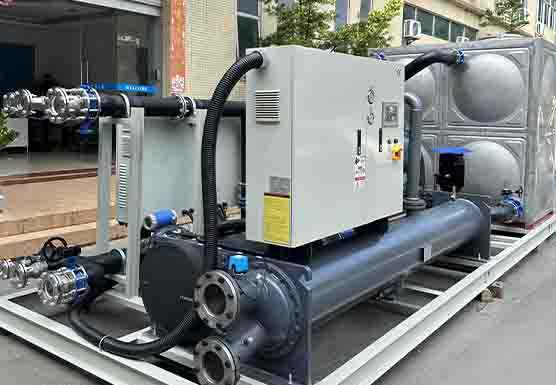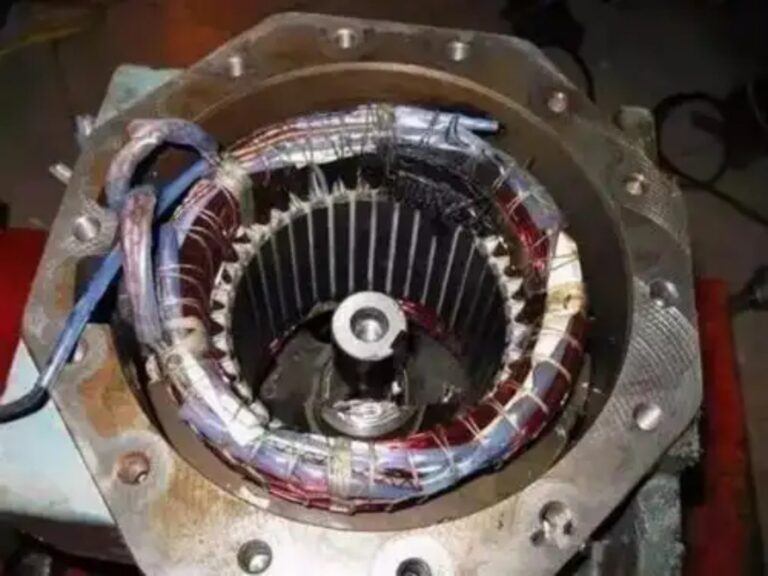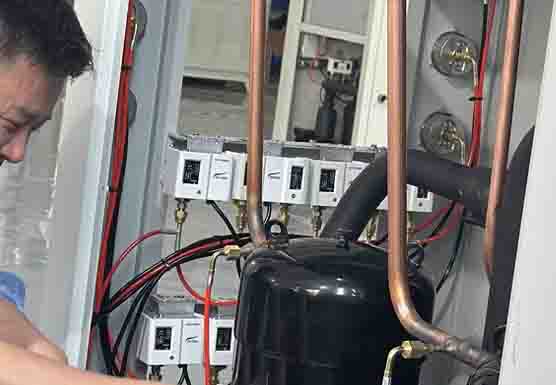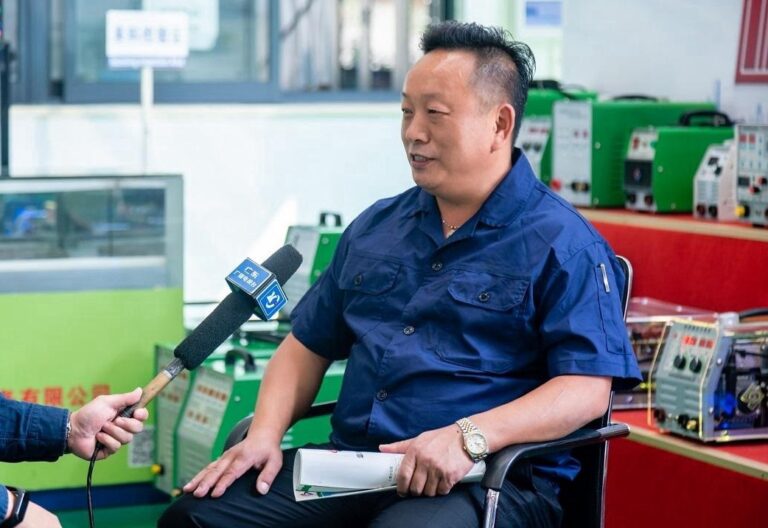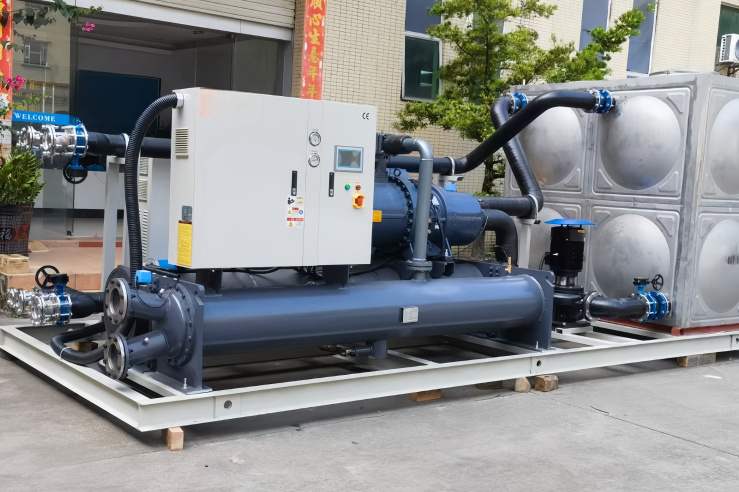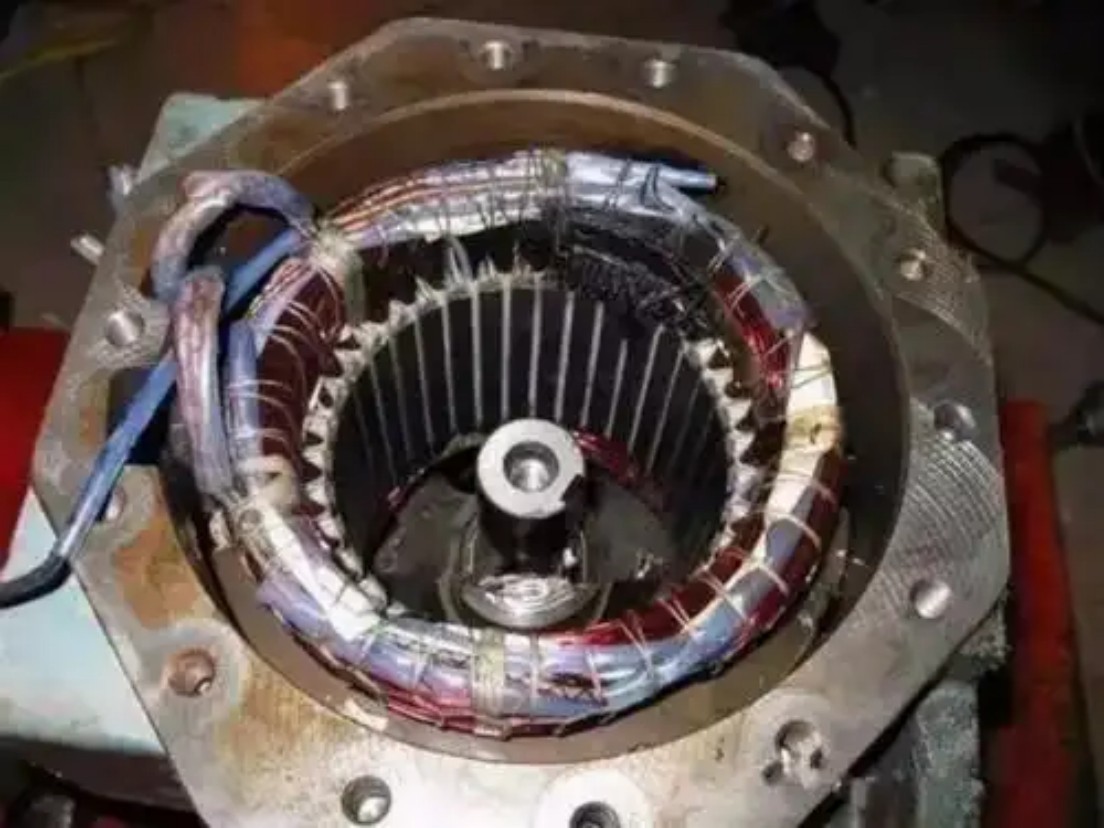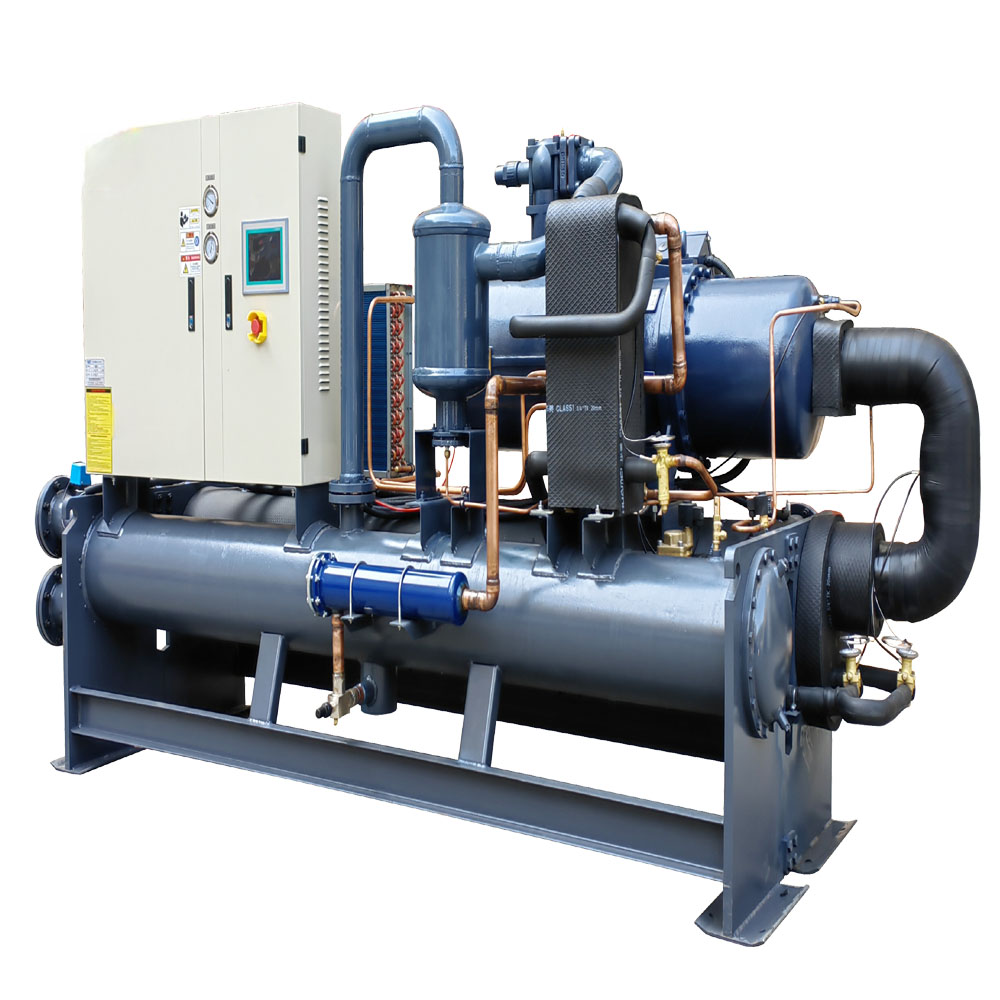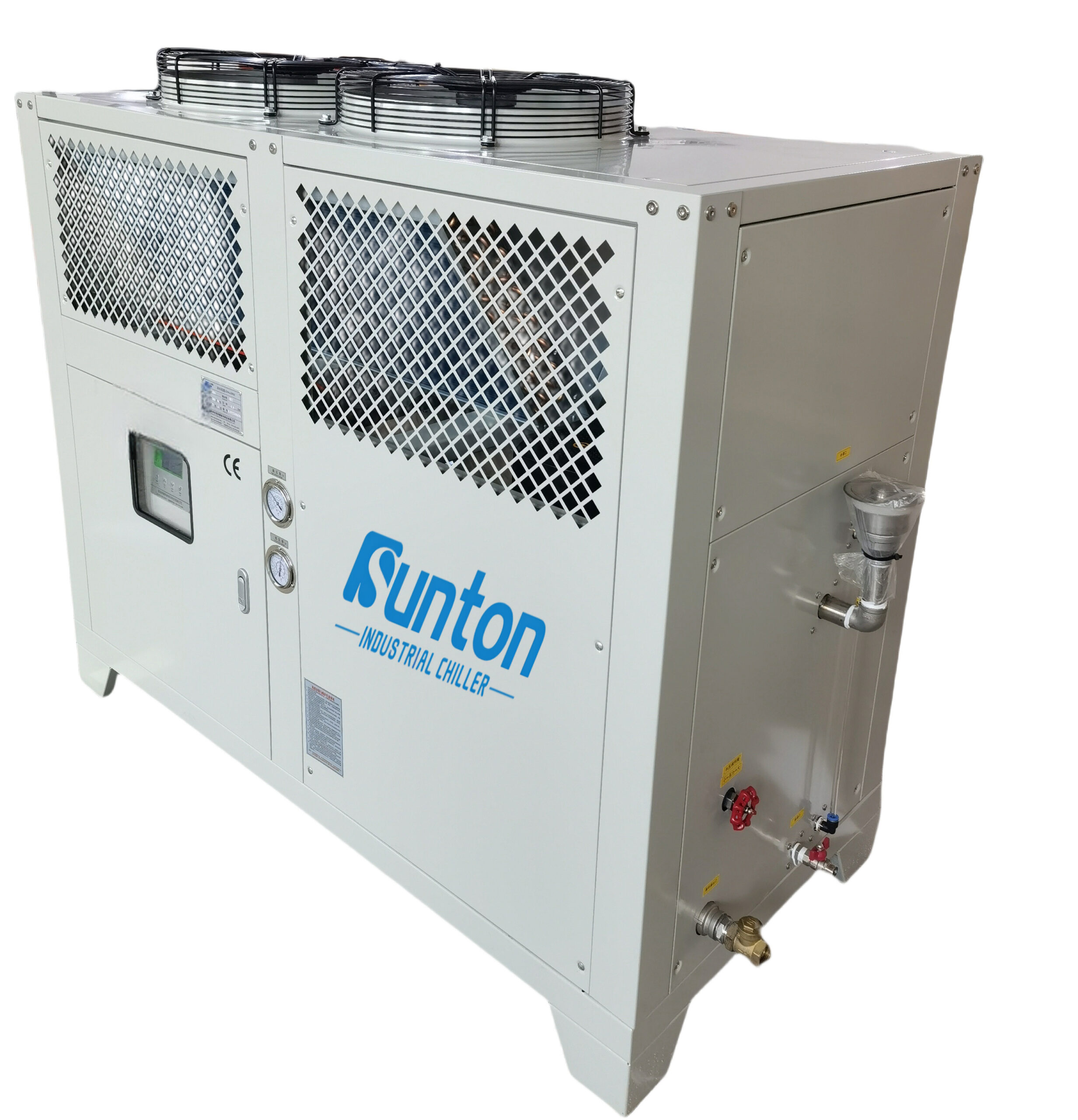-
Далиншань Индустриальный Гуандун

What are the 3 Types of Water-Cooled Condensers Used in Industrial Refrigeration?
Water-Cooled Condensers Used in Industrial Refrigeration
Water-cooled condenser types for industrial refrigeration: working, benefits, and uses.
Оглавление
What is a Water-Cooled Condenser and How Does It Work?
А конденсатор с водяным охлаждением является важнейшим компонентом во многих охлаждение systems, particularly in industrial settings. Unlike конденсаторы с воздушным охлаждением that use ambient air to cool the refrigerant, water-cooled condensers use water как охлаждение medium. This тип конденсатора является высокоэффективный because water has a higher capacity to absorb heat than air. In a water-cooled system, hot пар хладагента из компрессор входит в конденсатор, where it comes into contact with tubes or plates cooled by water flowing through the system. The передача тепла process causes the хладагент к конденсировать из а пар back into a liquid.
Condenser work involves removing тепло от хладагента, allowing it to change state. This is essential for the холодильный цикл to continue. The water-cooled condenser unit is typically connected to a градирня или другой источник охлаждающая вода that helps dissipate the heat from the condenser. This setup makes чиллеры с водяным охлаждением particularly effective in environments where air cooling is insufficient or where precise temperature control is necessary. Our water-cooled condensers особенность highly efficient water-cooled design that ensures optimal performance. We understand that every facility has unique needs, and we’re committed to helping you find the perfect конденсатор с водяным охлаждением решение.
What are the Three Primary Types of Water-Cooled Condensers?
Есть три основных типа конденсаторов используется в с водяным охлаждением systems: кожухотрубчатый, паяная пластина, and coaxial tube-in-tube. Each тип конденсатора offers unique benefits and is suited to different applications. Shell and tube condensers are known for their robustness and ease of maintenance, making them a popular choice in large industrial setups. A brazed plate heat exchanger provides a compact and efficient solution, ideal for applications with space constraints. Coaxial tube-in-tube конденсаторы, while less common in large-scale operations, are appreciated for their simplicity and effectiveness in smaller systems.
Понимание types of water-cooled systems available is crucial for selecting the right equipment. For example, the three types из water-cooled condensers each cater to specific needs within industrial and commercial applications. Whether you need to cool machinery in a plastics factory or maintain precise temperatures in a laboratory, the right тип конденсатора can significantly impact efficiency and performance. Water-cooled condensers use water from an external source to provide optimal охлаждение, making them a reliable choice for many industries.
How Does a Shell and Tube Condenser Work in Industrial Settings?
The shell and tube condenser is one of the most common types из water-cooled condensers используется в промышленное охлаждение. It consists of a цилиндрическая оболочка that houses a bundle of straight water tubes. Hot refrigerant vapor из компрессор входит в shell and flows around the outside of the tubes. Cooling water circulates through the water tubes, поглощающий тепло от хладагента. Этот передача тепла process causes the хладагент к конденсировать into a liquid.
In this type of конденсатор, water flows in the opposite direction to the хладагент максимизировать heat transfer rate. This counterflow arrangement ensures that the coldest water makes contact with the хладагент that is about to exit the конденсатор, enhancing efficiency. Shell and tube condensers are favored in industrial settings due to their ability to handle high pressures and their ease of cleaning. Maintenance often involves removing the end covers to access the water tubes for inspection and cleaning, helping to prevent коррозия and maintain optimal performance. They are commonly used to cool large volumes of хладагент in applications such as chemical processing and large-scale air conditioning systems.
What are the Advantages of Using a Brazed Plate Heat Exchanger as a Condenser?
А brazed plate heat exchanger used as a конденсатор offers a compact and высокоэффективный solution for охлаждение в система охлаждения. Этот тип конденсатора consists of a series of thin, corrugated plates that are brazed together to create a series of channels. Hot refrigerant и охлаждающая вода flow through alternating channels, facilitating rapid передача тепла. The large surface area provided by the plates, combined with the turbulent flow of the fluids, results in a very efficient передача тепла процесс.
One of the primary advantages of brazed plate condensers is their compact size. They require significantly less space than кожухотрубчатые конденсаторы, making them ideal for applications where space is limited, such as in packaged чиллеры с водяным охлаждением or in retrofitting existing systems. Additionally, brazed plate heat exchangers are known for their high efficiency and ability to operate with smaller temperature differences between the хладагент и охлаждающая вода. This can lead to lower потребление воды and reduced operating costs. As a manufacturing plant specializing in industrial water chillers, we can incorporate brazed plate heat exchangers into systems designed for industries like plastics, food processing, and laboratories.
Why are Coaxial Tube-in-Tube Condensers Less Common in Large Industrial Applications?
Coaxial tube-in-tube конденсаторы, также известный как shell and coil condensers, are a simpler type of water-cooled condenser. They consist of one tube (the outer tube) with a smaller катушка or tube inside it (the inner tube). Typically, охлаждающая вода flows through the inner катушка, пока hot refrigerant vapor flows in the space between the inner and outer tube. передача тепла occurs through the wall of the inner катушка, вызывая хладагент к конденсировать.
While coaxial конденсаторы are efficient and compact, they are less common in large industrial applications for several reasons. One key limitation is their difficulty in cleaning and maintenance. Unlike кожухотрубчатые конденсаторы, coaxial конденсаторы cannot be easily disassembled for cleaning, which can be a significant drawback in applications where water quality is poor or where the хладагент is prone to causing fouling. Additionally, the передача тепла capacity of coaxial конденсаторы is generally lower than that of кожухотрубчатый или паяная пластина options, making them less suitable for high-capacity промышленное охлаждение systems. However, they can still be a viable option for smaller, specialized applications where their simplicity and compact size are advantageous. We offer a range of конденсатор с водяным охлаждением solutions, including custom designs to fit specific industrial needs.
What Role Does Water Quality Play in the Efficiency of Water-Cooled Condensers?
Water quality is a critical factor in the performance and longevity of any конденсатор с водяным охлаждением. Impurities in the охлаждающая вода, such as minerals, sediment, and biological growth, can lead to scaling, fouling, and коррозия в пределах конденсатор. These issues can significantly reduce the передача тепла efficiency of the system and increase the risk of equipment failure. For example, hard water with high mineral content can cause scale buildup on the water tubes в shell and tube condenser or the plates in a brazed plate heat exchanger.
To mitigate these problems, it’s essential to use treated or filtered water in с водяным охлаждением systems. Regular monitoring of water quality and implementing appropriate water treatment measures, such as chemical treatments or filtration, can help maintain optimal performance. In some cases, using a градирня with a water treatment system can provide a continuous supply of clean охлаждающая вода. Proper maintenance, including regular cleaning and inspection of the water side принадлежащий конденсатор, is also crucial. Ensuring good water quality not only enhances the efficiency of the процесс охлаждения but also extends the lifespan of the equipment, reducing downtime and maintenance costs.
How to Choose the Right Water-Cooled Condenser for Your Industrial Needs?
Выбор подходящего конденсатор с водяным охлаждением for your industrial application involves considering several factors. First, assess the heat load of your system to determine the required конденсатор capacity. This will help you decide between different types of condensers used, такой как кожухотрубчатый, паяная пластина, or coaxial designs. Consider the available space for installation; if space is limited, a compact brazed plate heat exchanger might be preferable.
Water quality is another crucial consideration. If your water source is prone to causing scaling or fouling, a shell and tube condenser, which is easier to clean, might be a better choice. Evaluate the operating temperatures and pressures of your system to ensure the selected конденсатор can handle these conditions. Additionally, consider the energy efficiency of different condenser types. Brazed plate condensers often offer higher efficiency, which can lead to lower operating costs. In choosing the best option for your needs, it is essential to consider factors such as cooling capacity, flow rate, and pressure requirements.
Here is an image of a Glycol Chiller:
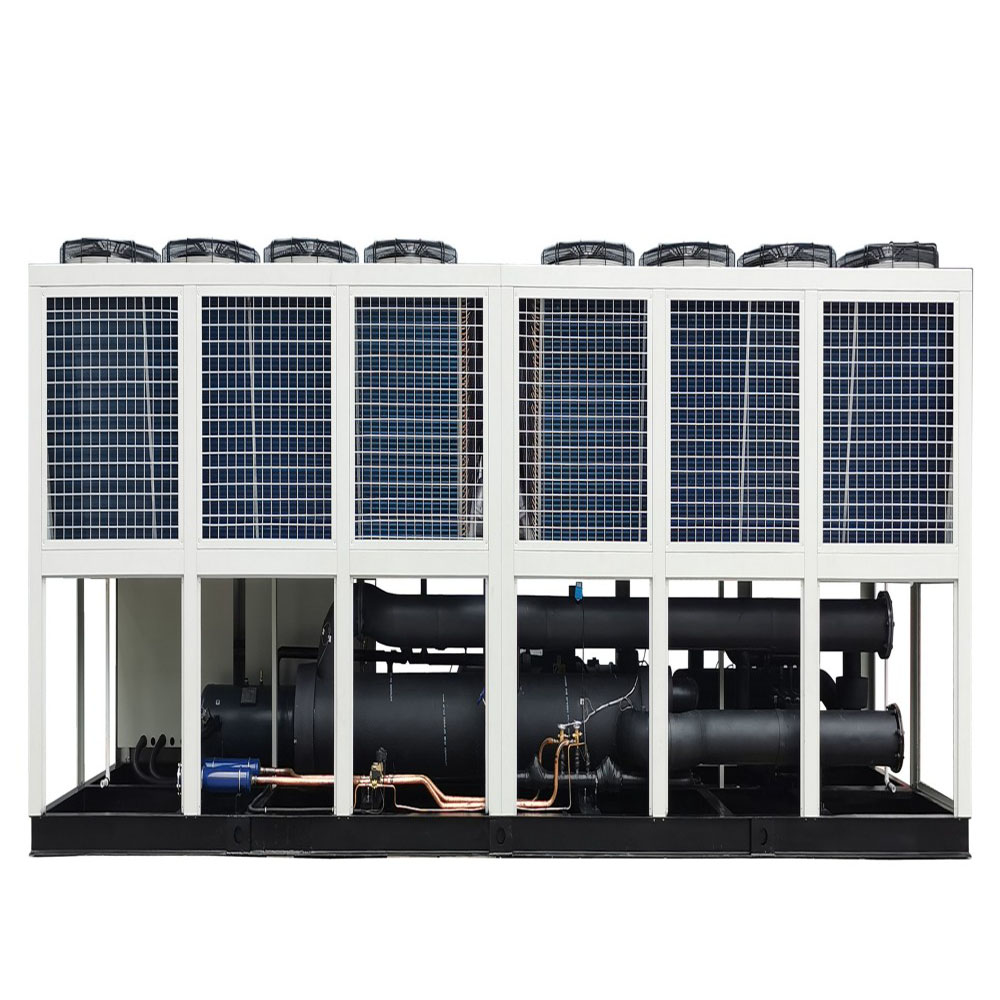
What Maintenance is Required for Water-Cooled Condensers to Ensure Longevity?
Regular maintenance is essential to keep water-cooled condensers operating efficiently and to extend their lifespan. The specific maintenance tasks depend on the тип конденсатора but generally include cleaning, inspecting for leaks, and monitoring water quality. For кожухотрубчатые конденсаторы, maintenance often involves removing the end covers to access the water tubes for cleaning. This helps remove any scale or fouling that can reduce передача тепла эффективность.
Brazed plate heat exchangers typically require less maintenance but should still be inspected regularly for signs of clogging or leakage. Chemical cleaning or backflushing may be necessary to maintain their performance. Monitoring the water quality and implementing appropriate water treatment measures are crucial for all types of water-cooled systems. Regular inspections should also include checking for коррозия and ensuring that all connections are secure. By establishing a proactive maintenance schedule, you can prevent unexpected downtime, reduce repair costs, and ensure your конденсатор с водяным охлаждением continues to provide reliable охлаждение for your industrial processes.
Can Water-Cooled Condensers Be Used with a Cooling Tower?
Да, water-cooled condensers are often used in conjunction with a градирня in many industrial applications. A градирня is a heat rejection device that removes waste heat from the condenser water and releases it into the atmosphere. In this setup, the water circulating через конденсатор поглощает тепло от хладагента and then flows to the градирня. Внутри градирня, the warm water is sprayed over a fill material, and outdoor air is drawn through the tower, causing some of the water to evaporate.
This evaporative процесс охлаждения reduces the temperature of the remaining water, which is then returned to the конденсатор to continue the cooling cycle. Using a градирня с конденсатор с водяным охлаждением allows for continuous operation and helps maintain optimal охлаждение efficiency. It’s particularly beneficial in applications where large amounts of heat need to be dissipated, such as in chemical plants, power generation, and large air conditioning systems. This combination is highly effective in maintaining consistent temperatures and ensuring efficient operation of the система охлаждения. Check HVAC Chiller Solutions page to learn more about HVAC applications.
What are the Environmental Impacts of Using Water-Cooled Condensers?
Пока water-cooled condensers offer high efficiency and are often preferred in industrial settings, they do have environmental implications that need to be considered. One primary concern is потребление воды. С водяным охлаждением systems, especially those using once-through охлаждение, can use significant amounts of water. However, systems that incorporate градирни can reduce water usage by recirculating and cooling the water.
Another environmental aspect is the potential for thermal pollution. If охлаждающая вода is discharged directly into a natural water body at a higher temperature, it can affect aquatic ecosystems. Proper management and treatment of discharge water are essential to mitigate this impact. Additionally, the energy consumption of с водяным охлаждением systems, including the компрессор and pumps, contributes to their overall environmental footprint. However, the high efficiency of water-cooled condensers, особенно паяная пластина designs, can lead to lower energy use compared to some с воздушным охлаждением alternatives.
Часто задаваемые вопросы
What are the main advantages of water-cooled condensers over air-cooled condensers?
Конденсаторы с водяным охлаждением offer higher efficiency, especially in high-temperature environments, because water is a more effective охлаждение medium than air. They provide more stable and precise temperature control, which is crucial for many industrial processes. Additionally, с водяным охлаждением systems are generally quieter and can be installed indoors, offering more flexibility in system design.
How often should I clean my water-cooled condenser?
The frequency of cleaning depends on the тип конденсатора and the quality of your охлаждающая вода. Shell and tube condensers may require cleaning every 6-12 months, while brazed plate heat exchangers might need less frequent cleaning. Regular monitoring of system performance and water quality can help determine the optimal cleaning schedule. Check Взрывобезопасные охладители page for specific needs.
Can I use any type of water in my water-cooled condenser?
It’s crucial to use treated or filtered water to prevent scaling, fouling, and коррозия. Hard water or water with high levels of impurities can significantly reduce the efficiency and lifespan of your конденсатор. Implementing a water treatment system, especially when using a градирня, can help maintain optimal water quality.
What is the typical lifespan of a water-cooled condenser?
При правильном обслуживании, конденсатор с водяным охлаждением can last 15-20 years or even longer. The lifespan depends on factors such as the тип конденсатора, operating conditions, water quality, and the quality of maintenance. Regular inspections and timely repairs can help maximize the longevity of your equipment.
Are water-cooled condensers more energy-efficient than air-cooled condensers?
В целом, да. Конденсаторы с водяным охлаждением, especially those using brazed plate heat exchangers, are often more energy-efficient than с воздушным охлаждением options. Water’s higher heat capacity allows for more efficient передача тепла, which can lead to lower energy consumption by the компрессор and overall system.
What industries benefit most from using water-cooled condensers?
Many industries that require precise temperature control and high охлаждение capacity benefit from water-cooled condensers. These include plastics and rubber manufacturing, chemical and pharmaceutical processing, food and beverage production, data centers, and large commercial buildings with centralized air conditioning systems. The Охладители молочного молока page provides information on specific uses in the dairy industry.
Заключение
- Конденсаторы с водяным охлаждением are crucial for efficient охлаждение in many industrial applications.
- Есть three primary types of water-cooled condensers: кожухотрубчатый, паяная пластина, and coaxial tube-in-tube.
- Shell and tube condensers are robust and easy to maintain, suitable for large industrial setups.
- Brazed plate heat exchangers offer compact and высокоэффективный решения.
- Water quality significantly impacts the performance and lifespan of water-cooled condensers.
- Regular maintenance, including cleaning and water treatment, is essential for optimal operation.
- Конденсаторы с водяным охлаждением can be effectively used with градирни for continuous охлаждение.
- Пока с водяным охлаждением systems have environmental considerations, their efficiency can lead to lower energy consumption compared to some alternatives.
- Выбор правильного конденсатор с водяным охлаждением involves considering factors like heat load, space availability, water quality, and operating conditions.
- Industries such as plastics, chemicals, food processing, and data centers greatly benefit from using water-cooled condensers.
By understanding these key points, industries can make informed decisions about implementing and maintaining конденсатор с водяным охлаждением systems, ensuring efficient and reliable охлаждение for their operations. If you’re ready to optimize your охлаждение system with a конденсатор с водяным охлаждением, contact us today to discuss your specific needs and explore our range of solutions! If you are working in textile industry check our Промышленные охладители для текстильной промышленности page. Here you can find more info about Промышленные охладители для сельского хозяйства.
